NitroX
|
| (.700 member) |
| 19/06/19 03:06 PM |

|
|
|
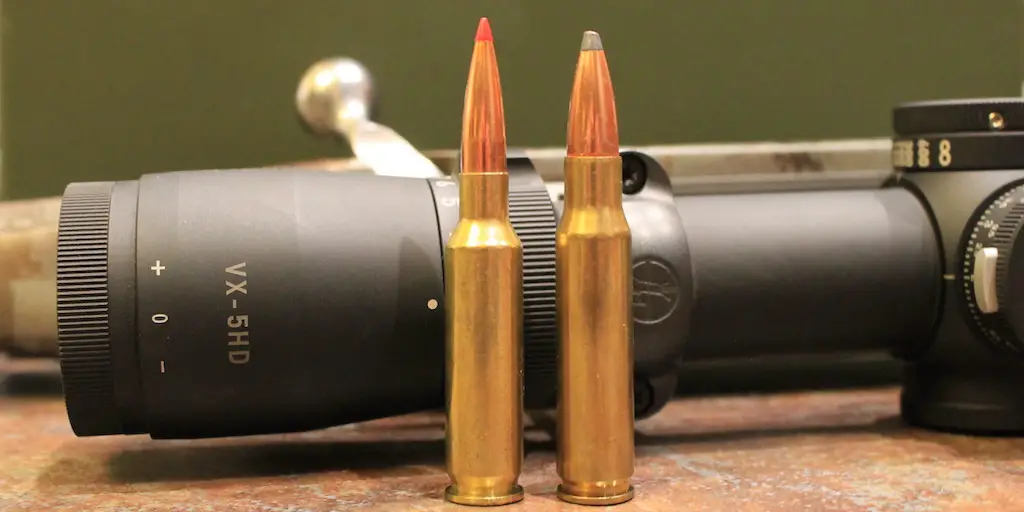
6.5 Creedmoor vs 308 Winchester Debate Settled
The rapid ascent of the 6.5 Creedmoor in recent years has ignited the 6.5 Creedmoor vs 308 debate among hunters.
Hereís what you need to know about these two cartridges.
I think most shooters agree that the .308 Winchester and 6.5 Creedmoor are both fantastic cartridges for competition shooting. While the .308 Winchester has been around for a long time and also has a well deserved reputation as an effective cartridge for hunting a variety of game, many hunters are skeptical of the capabilities of the comparatively new 6.5 Creedmoor as a hunting cartridge. So whatís the real deal with hunting with the 6.5 Creedmoor vs 308 Winchester?
Unfortunately, there is a lot of marketing hype as well as a few genuine misunderstandings regarding the capabilities of the 6.5 Creedmoor that complicate this discussion. For that reason, itís easy to understand how many hunters get confused about the strengths and weaknesses of the 6.5 Creedmoor and the .308 Winchester as hunting cartridges.
In this article, Iím going to discuss the pros and cons of the 6.5 Creedmoor vs 308 Winchester so you can make an informed decision on which one is right for your particular situation.
Before we get started, I have an administrative note:
Some of the links below are affiliate links. This means I will earn a small commission (at no extra cost to you) if you make a purchase. This helps support the blog and allows me to continue to create free content thatís useful to hunters like yourself. Thanks for your support.
6.5 Creedmoor vs 308: History
The story of the .308 Winchester begins right after World War II when American military leaders decided to replace the venerable .30-06 Springfield cartridge and M-1 Garand rifle. Though the cartridge and rifle performed admirably in the hands of American GIs, military leaders wanted a new rifle with a detachable magazine that was capable of fully automatic fire similar to the Soviet AK-47 or the German StG-44.
After several years of development and testing, the US Army replaced the M-1 Garand with the M-14 rifle chambered in the new 7.62x51mm cartridge. Like the .30-06, the new cartridge also fired a .308″ bullet. However, due to advances in powder technology since the introduction of the .30-06, the 7.62x51mm cartridge used a shorter case (51mm vs 63mm), but had virtually the same ballistics (a 147 gr bullet at 2,750 fps vs a 150 gr bullet at 2,700 fps) as the .30-06.
If youíd like to read a more detailed discussion on the 7.62x51mm cartridge and how it compares to the .30-06 Springfield, read this article:
308 vs 30-06 vs 300 Win Mag: Which Cartridge Should You Be Hunting With?
Around that same time, the leadership at Winchester saw a lot of potential for commercial success in the civilian hunting and shooting markets with the new 7.62x51mm cartridge and rolled out the extremely similar .308 Winchester. In short, the .308 Winchester could do virtually everything the .30-06 Springfield could do with up to a 180 grain bullet, but the new cartridge could fit in a short action rifle and had a slight edge in accuracy over the .
30-06.
As a result, the popularity of the new .308 Winchester cartridge gradually increased as hunters and shooters realized the inherent accuracy, efficiency, and power of the cartridge.
For these reasons, the .308 Winchester was one of the most popular short-action rifle cartridges for many decades and eventually became the standard against which other short-action cartridges were judged. Indeed, many of the other popular short-action cartridges (like the .243 Winchester, .260 Remington, and 7mm-08 Remington) were descended from the .308 Winchester.
Though the .308 Winchester was a very popular cartridge for high power rifle competition shooting for many years, Dave Emary and Dennis DeMille of Hornady Manufacturing saw an opportunity to build a new cartridge that outperformed the .308 Winchester in the early 2000s. Specifically, they wanted a cartridge that was just as accurate as the .308 at long distance, but with less recoil, less wind drift, and a flatter trajectory.
With that in mind, they modified a .30 Thompson Center (.30 TC) case to shoot .264″ bullets. The cartridge had a relatively large case capacity optimized for use with 4350 class propellants. They also built the accompanying rifle with a relatively fast 1:8″ rifling twist rate. When all was said and done, the new cartridge could accommodate long, heavy, high ballistic coefficient (BC) bullets in a short action magazine without intruding into the powder column.
Named the 6.5 Creedmoor in honor of the Creedmoor Matches, Emary and DeMille were quite successful in their goal of building the ideal competition shooting cartridge. The 6.5 Creedmoor does not have eye popping ballistics, but it has minimal recoil, is very accurate, and uses high BC bullets that retain energy and resist wind drift exceptionally well.
For those reasons, the cartridge has seen a great deal of success in the hands of competition shooters and has recently made the jump into the mainstream hunting community.
6.5 Creedmoor vs 308: Cartridge Sizes
You can see some of the similarities and differences between the 6.5 Creedmoor and .308 Winchester cartridges in the photo below.

Both cartridges are used in short action-rifles, so they have very similar external dimensions.
The .308 Winchester has a slightly longer same case length (1.92″ vs 2.015″), but the 6.5 Creedmoor has a little bit longer overall length (2.825″ vs 2.81″).
The 6.5 Creedmoor has a sharper shoulder angle and a slightly less tapered case than the .308. Those traits allow the Creedmoor to use very long, high BC bullets without sacrificing case capacity. 6.5 creedmoor vs 308 featuredBoth cartridges have the same .473″ rim diameter, can hold almost the same amount of powder, and have the same SAAMI maximum average pressure of 62,000psi.
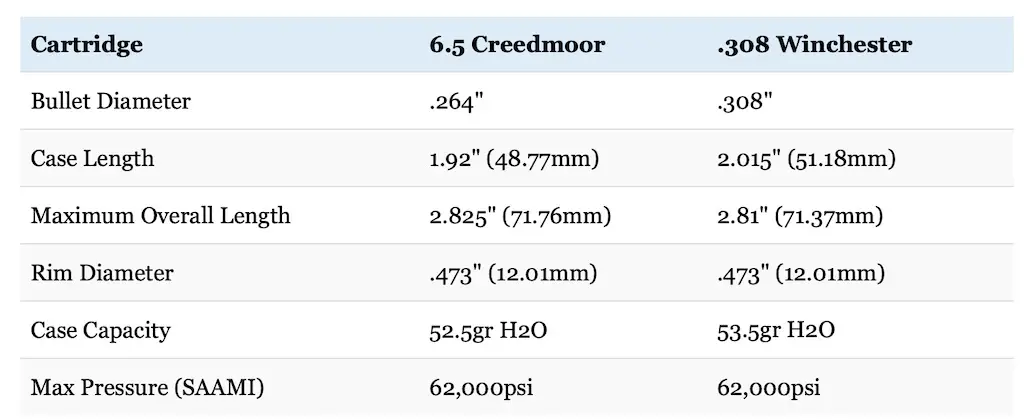
Note: while the case capacity figures listed below do give a good indication of the differences between the two cartridges, exact case capacities vary slightly according to the brand of brass used.6.5 creedmoor vs 308 size and pressure
6.5 Creedmoor vs 308 Ballistics
The table below compares 120gr Nosler E-Tip (.497 BC) and 143gr Hornady ELD-X (.625 BC) loads in 6.5 Creedmoor to 150gr Nosler E-Tip (.469 BC) and 178gr Hornady ELD-X (.552 BC) loads in .308 Winchester.
This data is for Hornady and Nosler factory ammo using a 24 inch barrel and a 200 yard zero.6.5 creedmoor vs 308 trajectory
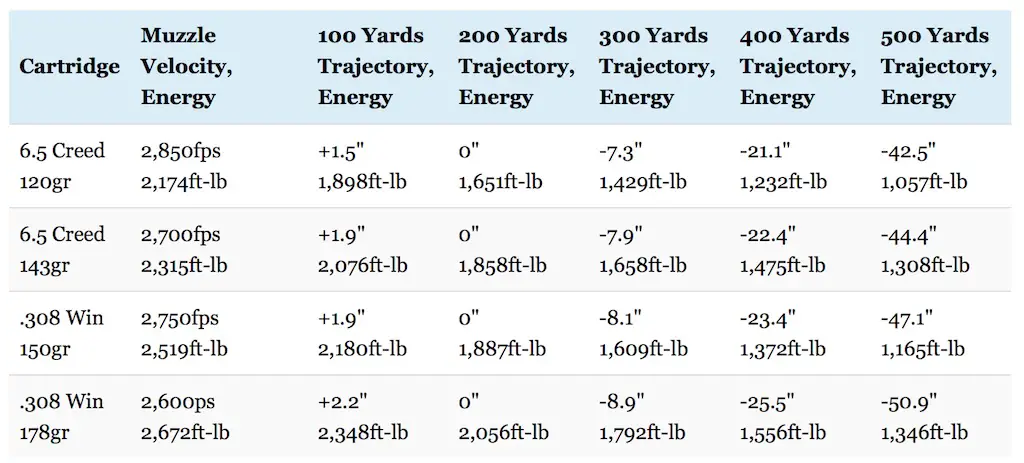
As you can see, the two cartridges have a very similar trajectory out to 300 yards. However, the 6.5 Creedmoor has a flatter trajectory overall, particularly at 400 and 500 yards. This due to the fact that the 6.5 Creedmoor fires a lighter bullet with a higher ballistic coefficient at a higher muzzle velocity than the comparable .308 Winchester load. Specifically, the Nosler E-Tip and ELD-X bullets from the Creedmoor have less bullet drop and hit 4.6″ and 6.5″ higher respectively than the same bullets from the .308 at 500 yards.
The .308 Winchester does start off with a big advantage in kinetic energy of 345 and 357 foot pounds of energy at the muzzle with the E-Tip and ELD-X. By 500 yards though, the ballistically superior 6.5mm bullets help narrow that gap down to 108 foot pounds with the E-Tip and just 38 foot pounds of energy with the ELD-X.
The chart below compares how much a 10 mile per hour crosswind impacts those same four loads out to 500 yards.
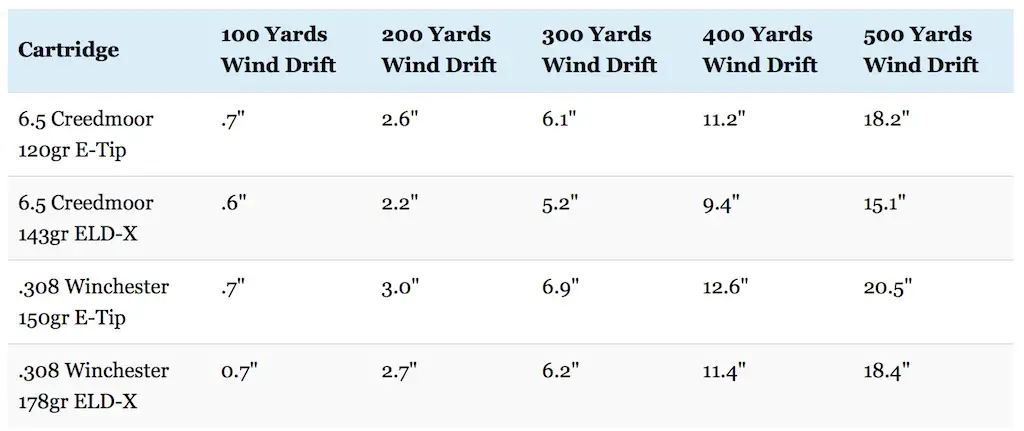
6.5 creedmoor vs 308 wind
The superior ballistic coefficient of the 6.5 Creedmoor helps give the cartridge a moderate advantage over the .308 Winchester in terms of wind drift. At 500 yards, the .308 Winchester E-Tip and ELD-X loads drift 2.3″ and 3.3″ more respectively than the comparable 6.5 loads.
However, the advantage isnít as pronounced at 500 yards as it is at longer ranges. Since this article is focused on the performance of these two cartridges for hunting, I didnít include any wind drift figures past 500 yards in the table above. Just to give you an idea how much the 6.5 Creedmoor advantage in wind drift grows during long range shooting though, the 6.5 Creedmoor ELD-X load drifts 70.1″ at 1,000 yards. This is nearly 1.5 feet less than the 87.4″ of wind drift for the .308 Winchester ELD-X at the same range.
Additionally, though the .308 Winchester is a relatively mild recoiling cartridge itself (especially compared to other .30 caliber cartridges like the .30-06 and .300 Win Mag), the 6.5 Creedmoor has a big advantage in this area as well. For example, when fired from a Ruger Hawkeye Predator rifle, the 178gr ELD-X from the .308 Winchester has about 30% more recoil than the 143gr ELD-X 6.5 Creedmoor load.
Felt recoil will vary from shooter to shooter and rifle to rifle, but free recoil energy is still a useful way to compare cartridges.picture of 6.5 creedmoor vs 308 winchester recoil
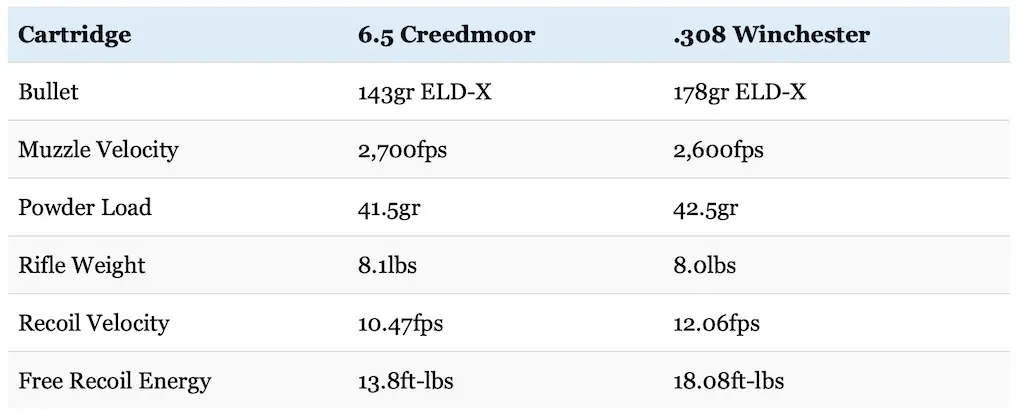
Most shooters should be able to handle the recoil of both cartridges, but the 6.5 Creedmoor has a pretty significant edge in this respect. Donít underestimate the impact that recoil has on the ability of a person to shoot accurately either. Regardless of how well a given person handles recoil, all other things being equal, they will absolutely shoot better with a milder recoil.
The 6.5 Creedmoor also has an advantage when it comes to bullet selection.
Since it was originally built for competition shooting, the cartridge was specifically designed to use the longest and heaviest 6.5mm (.264″) bullets available. This is why most 6.5 Creedmoor rifles have a fast 1:8″ rifling twist rate. The cartridge most often utilizes bullet weights in the 95-160 grain range, with 120, 129, 140, and 143gr bullets being the most common.
As we covered earlier, those longer and heavier .264″ bullets have a higher ballistic coefficient than the most common bullets used in the .308 Winchester. They also have a higher sectional density (SD).
Sectional density (SD) is a measure of the ratio of the diameter of a projectile to its mass. All other things equal, a heavier projectile of a given caliber will be longer and therefore have a higher sectional density and consequently penetrate deeper than projectiles with a lower mass and sectional density.
For instance, itís very uncommon to find .308 loads using bullets heavier than 180 grains.
A 180 grain .308″ bullet has a sectional density of .271 and a 168 grain .308″ bullet only has a sectional density of .253. However, a 143gr .264″ bullet has a sectional density of .293, which compares favorably to the most common .308″ bullets.
That being said, the .308 Winchester uses larger diameter bullets and consequently has about 36% more frontal surface area (also known as cross sectional area) than the 6.5 Creedmoor (.0745 vs .0547 square inches). All other things being equal, a bigger bullet will make a bigger hole, cause more tissue damage, and result in more blood loss.
Both cartridges have a long and distinguished history in the competition shooting realm and both cartridges are extremely accurate in the right hands at typical hunting ranges. However, the 6.5 Creedmoor most likely has a slight advantage in terms of accuracy as well.
In short, since it was specifically designed as a competition shooting cartridge and utilizes .264″ bullets, there is a bigger selection of high BC and high SD match grade hunting bullets available for the cartridge. Thatís not to say that the .308 Winchester isnít accurate or that there arenít a bunch of good quality bullets available for it. Itís just that the overall design of the 6.5 Creedmoor gives that cartridge an edge over the .308 Winchester.
So where do we stand overall with both cartridges?
With a flatter trajectory and less wind drift, the 6.5 Creedmoor does have a definite, though not gigantic, advantage over the .308 Winchester in external ballistics at typical hunting ranges. This makes the cartridge more forgiving of range or wind estimation errors than the .308 Winchester. It also has less recoil than the .308 Winchester as well as a large selection of high BC match grade hunting bullets.
All things considered, the 6.5 Creedmoor is a cartridge that helps maximize the shooting abilities and maximum effective range of the hunter to a greater extent than the .308 Winchester. Proper shot placement is extremely important when it comes to ethically taking game and the aforementioned strengths of the 6.5 Creedmoor all facilitate precise shot placement. Finally, the high SD bullets used by the 6.5 Creedmoor also assist with penetration to help the cartridge ďpunch above its weightĒ in a manner similar to the 7x57mm or 9.3x62mm Mauser cartridges.
On the other hand, the .308 carries more energy downrange than the Creedmoor and has a big advantage when it comes to frontal surface area. Those traits give hunters a tiny bit more room for error in shot placement when compared to the 6.5 Creedmoor.
It might seem like Iím splitting hairs here when talking about the strengths and weaknesses of the two cartridges. Thatís absolutely true to a certain degree.
While they certainly have different advantages, both cartridges are very accurate, relatively flat shooting, and hit hard enough for use on a variety of game out to several hundred yards. Regardless of whether youíre using a 6.5 Creedmoor or a .308 Winchester, no pronghorn, deer, or elk will go far if you put a well constructed bullet into the vitals.
6.5 Creedmoor vs 308: Ammunition Selection
The .308 Winchester is extremely popular among hunters and shooters in the United States and consistently ranks as one of the best selling cartridges in the country. The 6.5 Creedmoor is no slouch in this regard, but it still canít hold a candle to the .308 in terms of widespread use. Even so, the cartridge seems to be steadily growing in popularity, but only time will tell if it becomes as popular or widespread as the .308 though.
The big ammunition manufacturers like Barnes, Berger, Black Hills, Federal Premium, Hornady, HSM, Norma, Nosler, PPU Remington, Sellier & Bellot, Swift, and Winchester all produce a number of high quality 6.5 Creedmoor, and .308 Win factory ammunition suitable for hunting.
Most of the major bullet styles designed for hunting are available in those cartridges as well like the Barnes TTSX, the Berger VLD, the Hornady ELD-X, GMX, InterLock, SST, and V Max, the Nosler AccuBond, Ballistic Tip, E-Tip, and Partition, the Remington Core Lokt, and the Winchester Power Point.
Prices and availability vary from region to region, but ammunition for both cartridges is very common. The .308 Winchester is a much easier to find and a little less expensive than the 6.5 Creedmoor though.
Additionally, there is also still a large quantity of full metal jacket military surplus ammo in 7.62x51mm NATO out there. This ammunition isnít as inexpensive or easy to find as it used to be, but there are still good deals to be had if you look hard enough. Surplus FMJ ammo is ideal for practice, but those arenít great (or legal) hunting rounds in most states though.
Reloading components for all both cartridges are also widely available. Since the cartridges have the same bullet diameter as other popular cartridges like the 6.5x47mm Lapua, .264 Win Mag, .
30-06 Springfield, .300 Win Mag, and .300 WSM, there are plenty of .264″, and .308″ bullets of various weights and styles to choose from.
If youíd like to learn more about some of the various hunting ammunition choices for the 6.5 Creedmoor, read this article:
Best 6.5 Creedmoor Ammo For Hunting Elk, Deer, And Other Big Game
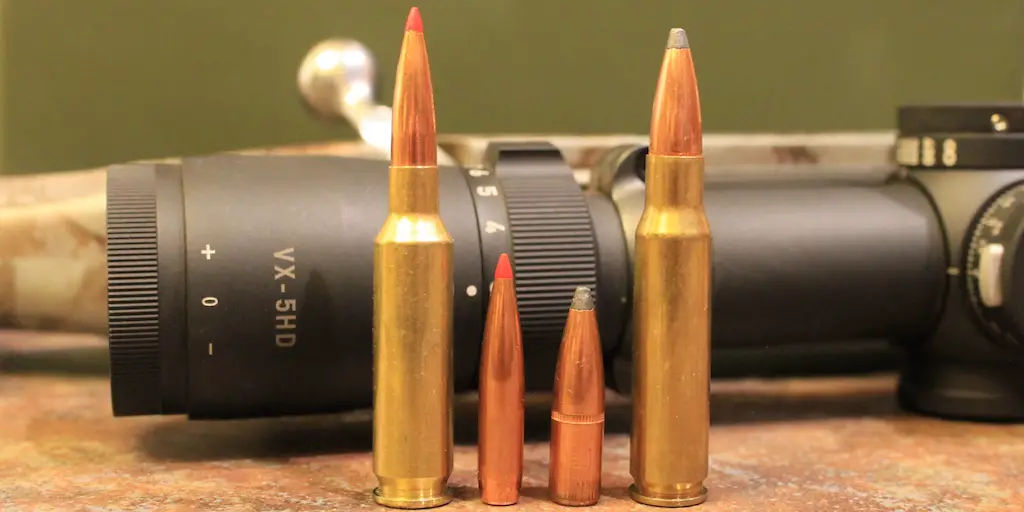
6.5 creedmoor vs 308 bullets6.5 Creedmoor vs 308: Rifle Selection
Along with the massive number of ammunition choices available in these cartridges, there are lots of quality rifles manufactured in 6.5 Creedmoor and .308 Winchester. Just like with ammunition though, .308 rifles are the most common (though 6.5 Creedmoor rifles are by no means rare).
To an even greater degree than most other gun manufacturers, Ruger has really gotten behind the 6.5 Creedmoor and offers their American, FTW Hunter, Hawkeye Long Range Target, Number 1, Precision, and Scout Rifles in both cartridges. Additionally, the Remington Model 700, Browning X-Bolt, Mossberg Patriot, Nosler M48, Savage Avis, Weatherby Vanguard, and the Winchester Model 70 are all bolt-action rifles available in 6.5 Creedmoor and .308 Winchester.
The .308 Winchester is also pretty common in semi-automatic sporting rifles like the AR-10 and M1A as well as military surplus rifles like the FN-FAL. The 6.5 Creedmoor is available in the AR-10 platform, but there arenít many other semi-auto rifles available in that cartridge.
Though there are some exceptions, since both are short-action cartridges, rifles of the same model chambered in each cartridge are virtually identical to each other. Depending on the exact model, 22″ and 24″ barrels are very common for both cartridges.
6.5 Creedmoor vs 308: Which Is Right For You?
The 6.5 Creedmoor and .308 Winchester are both flat shooting cartridges well suited for hunting thin skinned, small to medium sized animals like blacktail deer, mule deer, whitetail deer, fallow deer, or pronghorn.
While they are excellent choices for deer sized game, these cartridges, but particularly the .308 Winchester, are also suitable for bigger game under the right conditions. When using well constructed bullets and with proper shot placement, they will absolutely work for elk and even moose hunting at reasonable ranges. Theyíre also acceptable choices for hunting many species of African plains game.
Donít let anyone tell you that the 6.5 Creedmoor is too small for moose or elk. Scandinavian hunters have taken untold numbers of moose with the 6.5x55mm Swedish over the past century. That cartridge has ballistics very similar to the 6.5 Creedmoor and is a good example of what a high sectional density bullet will do on really big game animals with excellent shot placement.
That said, the 6.5 Creedmoor and .308 Winchester are definitely in a different league from heavy hitting cartridges like the 7mm Rem Mag and .300 Win Mag when it comes to hunting really tough, big, or dangerous game.
Do you primarily hunt medium sized game like deer, feral hogs, or black bear at ranges within 200 yards? Both cartridges with absolutely get the job done if you do your part and there isnít much of a difference between them ballistically inside of 300 yards.
Go with the .308 Winchester if you want the cheapest or easiest to find ammo.
Are you looking for a the better cartridge for hunting game like mule deer or pronghorn in open country where you might need to take a shot at several hundred yards? Both will also work in this role, but the 6.5 Creedmoor has a flatter trajectory, will drift less in the wind, and still carries enough energy out to 400-500 yards to cleanly take deer sized game without any issues.
Do you prefer to use a semi-automatic rifle for hunting or want a battle rifle for personal defense? Go with the .308 Winchester as there are many more quality rifles available in this cartridge than the 6.5 Creedmoor.
Are you sensitive to recoil? Go with the 6.5 Creedmoor.
Do you want the cartridge best suited for target shooting out to 1,200 yards or so in a precision rifle? Again, go with the 6.5 Creedmoor, which really stands head and shoulders above the .308 Winchester for long range precision shooting.
Do you want a cartridge well suited for elk, moose, caribou, kudu, eland, or red stag hunting? The .308 Winchester wins hands down here due to the big advantage the cartridge has in in frontal surface area as well as energy under 200 yards.
Like Iíve said many times before, the 6.5 Creedmoor and the .308 Winchester are both excellent rifle cartridges. While the differences between them (6.5 Creedmoor vs 308 Winchester) are pretty big in some areas, one isnít really ďbetterĒ than the other on the whole. Carefully evaluate your needs as a hunter based upon the circumstances you foresee using the cartridge in, get a good hunting rifle chambered in the cartridge you select, learn to shoot it well, use quality bullets, and youíll be all set for most hunting situations.
Nosler provided the data used to compare the recoil of the cartridges (here and here). The Lyman 50th Edition (183-184 & 241-245), and Hornady 10th Edition (317-322 & 474-484) reloading manuals were also used as references for the history of the cartridges and provided data to compare their size. Ballistic data for original 7.62x51mm cartridge was obtained from Inetres. Chuck Hawks provided case capacity data for the cartridges (here and here). The data used to compare the trajectory of the cartridges was obtained from Nosler (here and here) and Hornady (here and here). I used the Hornady Ballistic calculator and Shooters Calculator to compare wind drift and recoil for the cartridges.
https://thebiggamehuntingblog.com/65-creedmoor-vs-308-winchester/